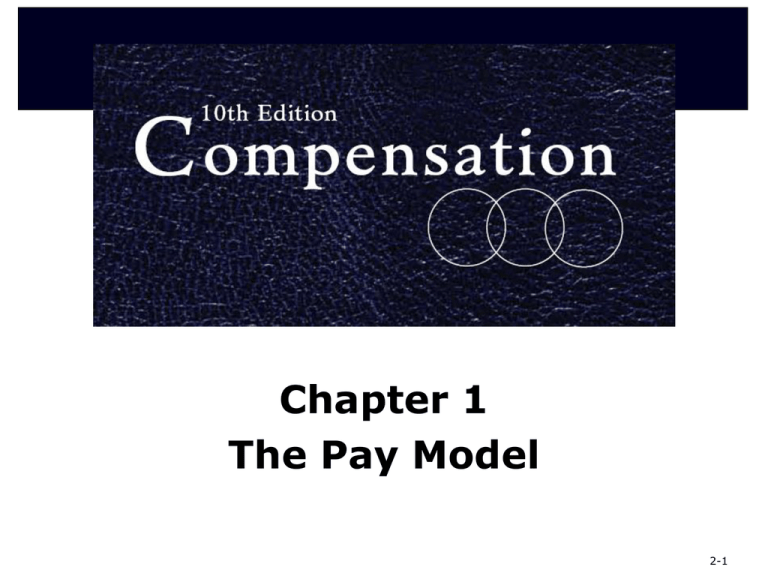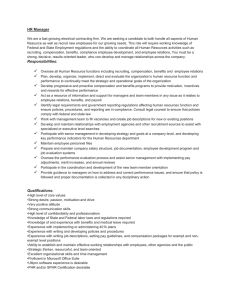
Chapter 1
The Pay Model
McGraw-Hill/Irwin
Copyright © 2011 by the McGraw-Hill Companies, Inc. All rights reserved.
2-1
Unit Topics
Compensation: Definition
Forms of Pay
A Pay Model
2-2
Perspectives of Compensation
Society’s
Views
Stockholders’
Views
Employees’
Views
Managers’
Views
2-3
Perspectives of Compensation
(cont.)
Society
Considers pay as a measure of justice
Benefits as a reflection of justice in
society
Stockholders
Using stock to pay employees creates a
sense of ownership and improves
performance
Linking executive pay to company
performance supposedly increases
stockholders' returns
2-4
Perspectives of Compensation
(cont.)
Managers
Major expense
Used to influence employee behaviors and
to improve the organization's
performance
2-5
Perspectives of Compensation
(cont.)
Employees
Major source of financial security
Return in an exchange between employer
and themselves
Entitlement for being an employee of the
company
Reward for a job well done
2-6
Perspectives of Compensation
(cont.)
Incentive and sorting effects of pay on
employers’ behaviors
Incentive effect - degree to which pay
influences individual and aggregate
motivation among the employees
Sorting effect - effect that pay can have
on the composition of the workforce
2-7
What is Compensation?
Compensation refers to all
forms of financial returns
and tangible services and
benefits employees
receive as part of an
employment relationship
2-8
Exhibit 1.4: Total Returns for Work
2-9
Forms of Pay
Base wage
It is the cash compensation that an
employer pays for the work performed
Some pay systems set base wage as a
function of the skill or education an
employee possesses
2-10
Forms of Pay
Merit pay/cost-of-living adjustments
Merit increases are given in recognition of
past work behavior
Cost-of-living adjustments give the same
increases to everyone, regardless of
performance
2-11
Forms of Pay (cont.)
Incentives (variable pay)
Tie pay increases directly to performance
Do not increase base wage; must be
reearned each pay period
Potential size of the payment will
generally be known beforehand
Are one-time payments, and do not
permanently increase labor costs
May be long-term (stock options) or
short-term
2-12
Forms of Pay (cont.)
Benefits
Income protection (Medical insurance,
retirement programs, life insurance, and
savings plans)
Work/life balance (vacations, jury duty,
financial planning, referrals for child and
elder care, telecommuting, nontraditional
schedules, nonpaid time off)
Allowances
2-13
Forms of Pay (cont.)
A present-value perspective shifts
comparison of today's initial offers to
consideration of future bonuses, merit
increases, and promotions
Relational returns from work
(nonfinancial returns) have a
substantial effect on employees’
behavior
2-14
Forms of Pay (cont.)
Network of returns is more likely to be
useful if bonuses, development
opportunities, and promotions all work
together
2-15
A Pay Model
Three basic building blocks:
Compensation objectives
Policies that form the foundation of the
compensation system
Techniques that make up the
compensation system
2-16
Compensation Objectives
Guide the design of the pay system
Serve as the standards for judging the
success of the pay system
2-17
Four Policy Choices
Internal alignment
Compares jobs or skill levels inside a
single organization
Pertains to the pay rates both for
employees doing equal work and for those
doing dissimilar work
2-18
Four Policy Choices (cont.)
Pay relationships within an organization
affect employee decisions to:
Stay with the organization
Become more flexible by investing in
additional training
Seek greater responsibility
2-19
Four Policy Choices (cont.)
External competitiveness
Focus – pay comparisons with competitors
Pay is ‘market driven’
Objective:
To ensure that pay is sufficient to attract and
retain employees
To control labor costs to ensure competitive
pricing of products/ services
2-20
Four Policy Choices (cont.)
Employee contributions
Directly affects employees’ attitudes and
work behaviors
Management
Focus - right people get the right pay for
achieving the right objectives in the right
way
2-21
Chapter 2
Strategy: The Totality of
Decisions
McGraw-Hill/Irwin
Copyright © 2011 by the McGraw-Hill Companies, Inc. All rights reserved.
2-22
Chapter Topics
Similarities and Differences in
Strategies
Strategic Choices
Support Business Strategy
Support HR Strategy
The Pay Model Guides Strategic Pay
Decisions
2-23
Chapter Topics (cont.)
Developing a Total Compensation
Strategy: Four Steps
Source of Competitive Advantage:
Three Tests
“Best Practices” versus “Best Fit”?
Guidance from the Evidence
Virtuous and Vicious Circles
2-24
Exhibit 2.1: Three Compensation
Strategies
2-25
Similarities and Differences
in Strategies
Different strategies within the same
industry
Different strategies within the same
company
2-26
Strategic Choices
Strategy refers to the fundamental
directions that an organization
chooses
A strategic perspective focuses on
those compensation choices that help
the organization gain and sustain
competitive advantage
2-27
Exhibit 2.2: Strategic Choices
2-28
Support Business Strategy
Pay systems should align with the
organization's business strategy
Based on contingency notions
When business strategies change, pay
systems should also change
2-29
Exhibit 2.3: Tailor the Compensation
System to the Strategy
2-30
The Pay Model Guides Strategic Pay
Decisions
Five strategic compensation choices:
Objectives
Internal alignment
External competitiveness
Employee contributions
Management
2-31
The Pay Model Guides Strategic Pay
Decisions (cont.)
These decisions, taken together, form
a pattern that becomes an
organization’s compensation strategy
Stated versus unstated strategies
2-32
Developing A Total Compensation
Strategy: Four Steps
Step 1: Assess total compensation
implications
Step 2: Map a total compensation
strategy
Step 3: Implement strategy
Step 4: Reassess
2-33
Exhibit 2.6: Key Steps in Formulating
a Total Compensation Strategy
2-34
Step 1: Assess Total Compensation
Implications
Business strategy and competitive
dynamics – understand the business
Changing customer needs
Competitors’ actions
Changing labor market conditions
Changing laws
Globalization
Competitive dynamics can be
assessed globally
2-35
Step 1: Assess Total Compensation
Implications (cont.)
HR strategy: Pay as a supporting
player or catalyst for change?
Pay strategy is influenced by how it fits
with other HR systems
Pay can be a supporting player, as in the
high-performance approach
Pay can take the lead and be a catalyst
for change
2-36
Step 1: Assess Total Compensation
Implications (cont.)
Culture/values
A pay system reflects the values that
guide an employer's behavior and
underlie its treatment of employees
Social and political context
Context refers to legal and regulatory
requirements, cultural differences,
changing workforce, demographics,
expectations etc
2-37
Step 1: Assess Total Compensation
Implications (cont.)
Employee preferences
How to better satisfy individual needs and
preferences
Choice
People do not understand the
alternatives; too many choices confuse
them
Challenging to design and manage
2-38
Step 1: Assess Total Compensation
Implications (cont.)
Union preferences
Union preferences for different forms of
pay and their concern with job security
affect pay strategy
Unions' interests can differ
Compensation deals with unions can be
costly to change
2-39
Step 2: Map a Total Compensation
Strategy
A strategic map offers a picture of a
company’s compensation strategy
based on the five choices in the pay
model
Clarifies the message the company is
trying to establish with its
compensation system
Maps do not tell which strategy is the
“best”; provides a framework and
guidance
2-40
Exhibit 2.8: Contrasting Maps of
Microsoft and SAS
2-41
Steps 3 and 4: Implement and
Reassess
Step 3
Involves implementing the strategy
through the design and execution of the
compensation system
Step 4
Recognizes that the strategy must change
to fit changing conditions
Involves periodic reassessment
2-42
Sources of Competitive Advantage:
Three Tests
Is it aligned?
Does it differentiate?
Does it add value?
Calculate the return on investment (ROI)
2-43
“Best Practices” versus “Best Fit”?
Best Practices
Assumptions:
A set of best-pay
practices exists
Practices can be applied
universally across all
situations
Results in better
performance with almost
any business strategy
Best Fit
A company is more
likely to achieve
competitive
advantage if the
pay system:
Reflects company’s
strategy and values
Is responsive to
employees’ and unions’
needs
Is globally competitive
2-44
Guidance from the Evidence
Internal alignment
Pay differences among internal jobs can
affect results
External competitiveness
Paying higher than the average paid by
competitors can affect results
Employee contributions
Performance-based pay can affect results
2-45
Guidance from the Evidence (cont.)
Managing compensation
All dimensions of the pay strategy need
to be considered
Compensation strategy
Embedding compensation strategy
within the broader HR strategy affects
results
“What practices pay off best under
what conditions” is an important
question to be answered
2-46
Virtuous and Vicious Circles
A study concluded that how you pay
matters as much as how much you
pay
Studies conclude that performancebased pay that shares success with
employees improves employee
attitudes, behaviors, performance –
especially when combined with highperformance practices
2-47
Virtuous and Vicious Circles (cont.)
Performance-based pay can be the
best practice under right
circumstances
2-48






